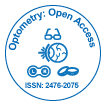Exploring Corneal Topography: Principles, Applications and Clinical Insights
Received: 01-Jul-2024 / Manuscript No. omoa-24-141721 / Editor assigned: 03-Jul-2024 / PreQC No. omoa-24-141721 (PQ) / Reviewed: 17-Jul-2024 / QC No. omoa-24-141721 / Revised: 19-Jul-2024 / Manuscript No. omoa-24-141721 (R) / Published Date: 26-Jul-2024
Abstract
Corneal topography has emerged as a cornerstone in modern ophthalmic diagnostics, providing detailed assessments of the corneal shape, curvature, and surface regularity. This article delves into the principles, advancements, applications, and clinical significance of corneal topography in the field of eye care.
keywords
Corneal topography; Eye care; Scheimpflug imaging
Introduction
Corneal topography utilizes advanced imaging technology to generate three-dimensional maps of the corneal surface. Traditional corneal topographers employ Placido disc technology, where concentric rings of light are projected onto the cornea. The reflected pattern is captured by a camera positioned at a fixed distance, generating a series of concentric rings that correspond to the corneal curvature. By analyzing the distortion and spacing of these rings, corneal curvature and irregularities can be accurately quantified. Modern corneal topographers utilize Scheimpflug imaging technology, which captures anterior segment images by rotating a camera along an arc around the eye. This technique provides comprehensive cross-sectional views of the cornea and anterior chamber, enabling precise measurements of corneal thickness, elevation, and curvature across different meridians [1-4].
Methodology
Corneal topography systems integrate computerized algorithms to analyze raw data and reconstruct three-dimensional corneal maps. These maps depict variations in corneal curvature, astigmatism, and elevation, highlighting subtle irregularities that may indicate corneal diseases such as keratoconus, pellucid marginal degeneration, or post-surgical complications.
Advancements in corneal topography
Recent advancements in corneal topography have expanded its capabilities and clinical utility:
Improved camera technology and image processing algorithms have enhanced the spatial resolution of corneal topography systems. High-resolution maps provide detailed visualization of corneal structures, facilitating precise measurements and early detection of subtle changes in corneal morphology.
Corneal topographers now incorporate wavefront analysis to assess higher-order aberrations (HOAs) of the cornea, beyond traditional measures of curvature and astigmatism. Wavefront-guided corneal treatments utilize these detailed measurements to optimize outcomes in refractive surgeries like LASIK and PRK, correcting optical imperfections to improve visual acuity and reduce postoperative symptoms.
Corneal topography guides personalized treatment planning in refractive surgery, contact lens fitting, and corneal disease management. By tailoring interventions based on individual corneal characteristics, clinicians can achieve better visual outcomes and patient satisfaction [5-8].
Applications of corneal topography
Corneal topography finds diverse applications across ophthalmic specialties and clinical scenarios:
Preoperative corneal topography is essential for assessing candidacy and planning personalized refractive procedures. It helps surgeons determine the optimal treatment zone, calculate tissue ablation depth, and predict visual outcomes following LASIK, PRK, and other vision correction surgeries.
Corneal topography plays a pivotal role in fitting specialty contact lenses, particularly for patients with irregular corneal surfaces due to conditions like keratoconus or corneal transplants. By mapping corneal irregularities, topography guides the selection of lens parameters that optimize comfort, vision quality, and corneal health.
In diagnosing corneal diseases such as keratoconus, pellucid marginal degeneration, and corneal dystrophies, corneal topography aids in detecting early signs of pathology, monitoring disease progression, and evaluating treatment efficacy. Changes in corneal curvature and thickness detected by topography provide objective metrics for assessing disease severity and guiding therapeutic interventions.
Clinical insights and future directions
Corneal topography continues to evolve with technological innovations and research advancements:
AI-driven algorithms analyze corneal topography data to improve diagnostic accuracy, predict disease progression, and optimize treatment outcomes. Machine learning models can identify subtle patterns in corneal maps that correlate with specific corneal conditions, supporting early intervention and personalized management strategies.
Remote corneal topography platforms enable telemedicine consultations and remote monitoring of corneal health, expanding access to specialized eye care services and facilitating timely interventions in underserved populations.
Integration of corneal topography with other imaging modalities, such as anterior segment OCT and endothelial microscopy, enhances comprehensive corneal assessment. Multimodal imaging provides complementary information on corneal structure, thickness, and endothelial cell health, supporting holistic patient care and facilitating interdisciplinary collaboration [9,10].
Conclusion
Corneal topography plays a pivotal role in contemporary ophthalmic practice, offering detailed insights into corneal morphology, curvature, and irregularities. By combining advanced imaging technology with computerized analysis, corneal topography supports personalized treatment planning in refractive surgery, contact lens fitting, and management of corneal diseases. Embracing technological innovations and leveraging AI-driven analytics will further enhance the diagnostic precision and therapeutic efficacy of corneal topography, paving the way for improved visual outcomes and enhanced patient care in the field of ophthalmology.
References
- https://www.semanticscholar.org/paper/Introduction%3A-sustainable-mining-in-the-future-Allan/7892b2e82c6aebe6ed1656d65513ee7181e29001
- Estevez AM (2013)Sustainable development of mining mineral resources. Journal of Sustainable Mining.
- Esteves AM (2008) Mining and social development: refocusing community investment using multi-criteria decision analysis. Resources Policy 33:39-47.
- Monteiro NB (2019) Sustainable development goals in mining. Journal of Cleaner Production 228.
- https://www.researchgate.net/publication/326925600_Water_Pollution_Resulting_From_Mining_Activity_An_Overview
- https://www.researchgate.net/publication/352546488_The_contribution_of_mining_sector_to_sustainable_development_in_Saudi_Arabia
- Worlanyo AS (2022) The impacts of gold mining on the welfare of local farmers in Asutifi-North District in Ghana: a quantitative and multi-dimensional approach. Resources Policy 75: 102458.
- https://www.researchgate.net/profile/Richard-Amoako-3/publication/273771820_Environmental_and_Security_Aspects_of_Contemporary_Small_Scale_Mining_in_Ghana/links/550c453d0cf212874160b19b/Environmental-and-Security-Aspects-of-Contemporary-Small-Scale-Mining-in-Ghana.pdf
- https://www.semanticscholar.org/paper/Is-gold-mining-a-bane-or-a-blessing-in-Sub-Saharan-Appiah-Buaben/71bfb26f7ac1ce1904a2cd923d11651722cb69ce
- Aubynn T (2013) Mining and Sustainable Development: The Case of Ghana.
Citation: Riya D (2024) Exploring Corneal Topography: Principles, Applicationsand Clinical Insights. Optom Open Access 9: 271.
Copyright: © 2024 Riya D. This is an open-access article distributed under theterms of the Creative Commons Attribution License, which permits unrestricteduse, distribution, and reproduction in any medium, provided the original author andsource are credited.
Select your language of interest to view the total content in your interested language
Share This Article
Recommended Journals
Open Access Journals
Article Usage
- Total views: 1103
- [From(publication date): 0-2024 - Dec 14, 2025]
- Breakdown by view type
- HTML page views: 782
- PDF downloads: 321
